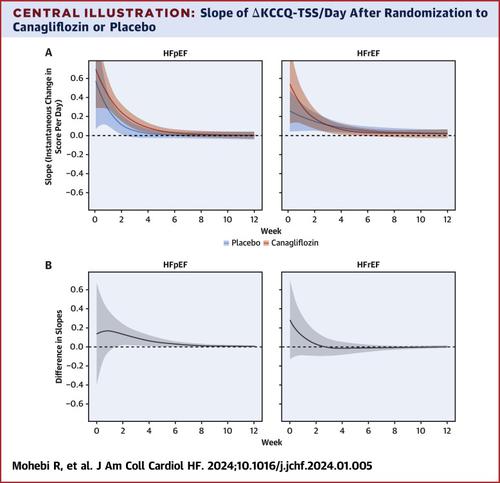当前位置:
X-MOL 学术
›
JACC Heart Fail.
›
论文详情
Our official English website, www.x-mol.net, welcomes your feedback! (Note: you will need to create a separate account there.)
Early Longitudinal Change in Heart Failure Health Status Following Initiation of Canagliflozin
JACC: Heart Failure ( IF 13.0 ) Pub Date : 2024-02-21 , DOI: 10.1016/j.jchf.2024.01.005 Reza Mohebi , Philip G. Jones , John A. Spertus , Ildiko Lingvay , David E. Lanfear , Kensey L. Gosch , Mary Birmingham , Mikhail N. Kosiborod , Javed Butler , James L. Januzzi
JACC: Heart Failure ( IF 13.0 ) Pub Date : 2024-02-21 , DOI: 10.1016/j.jchf.2024.01.005 Reza Mohebi , Philip G. Jones , John A. Spertus , Ildiko Lingvay , David E. Lanfear , Kensey L. Gosch , Mary Birmingham , Mikhail N. Kosiborod , Javed Butler , James L. Januzzi

|
Sodium glucose co-transporter 2 inhibitor (SGLT2i) therapy improves health status in heart failure (HF). There is insufficient description regarding the timing, rate, and extent of the health status changes in heart failure with preserved ejection fraction (HFpEF) and heart failure with reduced ejection fraction (HFrEF) after initiation of SGLT2is. The authors sought to model the association of canagliflozin treatment with rates of change in HF symptom status in HFpEF and HFrEF. Study participants with HFrEF and HFpEF were treated with either canagliflozin 100 mg or placebo for 12 weeks. The Kansas City Cardiomyopathy Questionnaire Total Symptom Score (KCCQ-TSS) was assessed at baseline and at 2, 4, 6, and 12 weeks. Longitudinal modeling assessed slope of KCCQ change across the study. Among 448 individuals with HF (181 with HFrEF and 267 with HFpEF), participants with HFpEF had lower baseline KCCQ-TSS scores than those with HFrEF (54 ± 21 vs 64 ± 20). Modeling demonstrated initial rapid improvement in KCCQ-TSS in both HF groups, with deceleration over the next 4 to 6 weeks. The rate of change was greater among HFpEF participants (0.7 points/day; 95% CI: 0.3-1.1 points/day) than HFrEF participants (ΔKCCQ-TSS/day = 0.5; 95% CI: 0.1-1.0 points/day) randomized to canagliflozin, but these differences were not statistically significant (0.2 points/day; 95% CI: –0.4 to 0.7 points/day; 056). After canagliflozin therapy, regardless of EF, modeling shows the KCCQ-TSS improves rapidly with the greatest improvements occurring within the first weeks of treatment. These results have implications for clinical use of SGLT2is and may be useful in the design of trials examining impact of these agents on health status in HF. (A Study on Impact of Canagliflozin on Health Status, Quality of Life, and Functional Status in Heart Failure [CHIEF-HF]; )
中文翻译:

开始使用卡格列净后心力衰竭健康状况的早期纵向变化
钠葡萄糖协同转运蛋白 2 抑制剂 (SGLT2i) 治疗可改善心力衰竭 (HF) 的健康状况。关于 SGLT2is 启动后射血分数保留的心力衰竭 (HFpEF) 和射血分数降低的心力衰竭 (HFrEF) 健康状况变化的时间、速率和程度没有充分的描述。作者试图建立卡格列净治疗与 HFpEF 和 HFrEF 心力衰竭症状状态变化率之间的关系模型。患有 HFrEF 和 HFpEF 的研究参与者接受 100 mg 卡格列净或安慰剂治疗 12 周。在基线以及第 2、4、6 和 12 周时评估堪萨斯城心肌病问卷总症状评分 (KCCQ-TSS)。纵向模型评估了整个研究中 KCCQ 变化的斜率。在 448 名 HF 个体中(181 名 HFrEF 和 267 名 HFpEF),HFpEF 参与者的基线 KCCQ-TSS 评分低于 HFrEF 参与者(54 ± 21 vs 64 ± 20)。模型显示两个心力衰竭组的 KCCQ-TSS 最初快速改善,但在接下来的 4 至 6 周内减速。 HFpEF 参与者的变化率(0.7 点/天;95% CI:0.3-1.1 点/天)比随机 HFrEF 参与者(ΔKCCQ-TSS/天 = 0.5;95% CI:0.1-1.0 点/天)更大与卡格列净相比,但这些差异不具有统计学显着性(0.2 点/天;95% CI:–0.4 至 0.7 点/天;056)。卡格列净治疗后,无论 EF 如何,模型显示 KCCQ-TSS 迅速改善,最大改善发生在治疗的第一周内。这些结果对 SGLT2is 的临床使用具有影响,并且可能有助于设计研究这些药物对心力衰竭健康状况影响的试验。 (坎格列净对心力衰竭患者健康状况、生活质量和功能状态影响的研究 [CHIEF-HF];)
更新日期:2024-02-21
中文翻译:

开始使用卡格列净后心力衰竭健康状况的早期纵向变化
钠葡萄糖协同转运蛋白 2 抑制剂 (SGLT2i) 治疗可改善心力衰竭 (HF) 的健康状况。关于 SGLT2is 启动后射血分数保留的心力衰竭 (HFpEF) 和射血分数降低的心力衰竭 (HFrEF) 健康状况变化的时间、速率和程度没有充分的描述。作者试图建立卡格列净治疗与 HFpEF 和 HFrEF 心力衰竭症状状态变化率之间的关系模型。患有 HFrEF 和 HFpEF 的研究参与者接受 100 mg 卡格列净或安慰剂治疗 12 周。在基线以及第 2、4、6 和 12 周时评估堪萨斯城心肌病问卷总症状评分 (KCCQ-TSS)。纵向模型评估了整个研究中 KCCQ 变化的斜率。在 448 名 HF 个体中(181 名 HFrEF 和 267 名 HFpEF),HFpEF 参与者的基线 KCCQ-TSS 评分低于 HFrEF 参与者(54 ± 21 vs 64 ± 20)。模型显示两个心力衰竭组的 KCCQ-TSS 最初快速改善,但在接下来的 4 至 6 周内减速。 HFpEF 参与者的变化率(0.7 点/天;95% CI:0.3-1.1 点/天)比随机 HFrEF 参与者(ΔKCCQ-TSS/天 = 0.5;95% CI:0.1-1.0 点/天)更大与卡格列净相比,但这些差异不具有统计学显着性(0.2 点/天;95% CI:–0.4 至 0.7 点/天;056)。卡格列净治疗后,无论 EF 如何,模型显示 KCCQ-TSS 迅速改善,最大改善发生在治疗的第一周内。这些结果对 SGLT2is 的临床使用具有影响,并且可能有助于设计研究这些药物对心力衰竭健康状况影响的试验。 (坎格列净对心力衰竭患者健康状况、生活质量和功能状态影响的研究 [CHIEF-HF];)



























 京公网安备 11010802027423号
京公网安备 11010802027423号